Assessing Integrated Effectiveness of Rural Socio-Economic Development and Environmental Protection of Wenchuan County in Southwestern China: An Approach Using Game Theory and VIKOR
Abstract
1. Introduction
2. Materials and Methods
2.1. Current Status of the IERSE in Wenchuan
2.2. Assessment Indicator System and Data Sources
2.3. Indicator Empowerment
2.3.1. AHP
2.3.2. CRITIC
2.3.3. Combined Weight Based on Game Theory
2.4. Assessment Method
2.5. Spatial Correlation Analysis
3. Results
3.1. The IERSE in Wenchuan County
3.2. Restrictive Factors of IERSE in Wenchuan County
4. Discussion
5. Conclusions
Author Contributions
Funding
Data Availability Statement
Conflicts of Interest
References
- Li, C.; Yuan, B.L.; Zhang, Y.P. Effect Assessment of Ecological Construction in China from 2008 to 2014. Pol. J. Environ. Studies 2019, 28, 1241–1246. [Google Scholar] [CrossRef]
- Huang, L.; Shao, Q.Q.; Liu, J.Y. Forest restoration to achieve both ecological and economic progress, Poyang Lake basin, China. Ecol. Eng. 2012, 44, 53–60. [Google Scholar]
- United Nations. Transforming Our World: The 2030 Agenda for Sustainable Development; United Nations, Department of Economic and Social Affairs: New York, NY, USA, 21 October 2015.
- Hák, T.; Janoušková, S.; Moldan, B. Sustainable Development Goals: A need for relevant indicators. Ecol. Indic. 2016, 60, 565–573. [Google Scholar] [CrossRef]
- Huan, Y.Z.; Liang, T.; Li, H.T.; Zhang, C.S. A systematic method for assessing progress of achieving sustainable development goals: A case study of 15 countries. Sci. Total Environ. 2021, 75, 141875. [Google Scholar] [CrossRef]
- Bernhard, W.; Harald, V. Evaluating Sustainable Forest Management Strategies with the Analytic Network Process in a Pressure-State-Response Framework. J. Environ. Manag. 2008, 88, 1–10. [Google Scholar]
- Bravo, G. The Human Sustainable Development Index: The 2014 Update. Ecol. Indic. 2015, 50, 258–259. [Google Scholar] [CrossRef]
- Malekmohammadi, B.; Jahanishakib, F. Vulnerability assessment of wetland landscape ecosystem services using driver-pressure-state-impact-response (DPSIR) model. Ecol. Indic. 2017, 82, 293–303. [Google Scholar] [CrossRef]
- Esen, Ö.; Yıldırım, D.Ç.; Yıldırım, S. Threshold effects of economic growth on water stress in the Eurozone. Environ. Ment. Sci. Pollut. Res. 2020, 27, 31427–31438. [Google Scholar] [CrossRef]
- Wackernagel, M.; Rees, W. Our Ecological Footprint: Reducing Human Impact on the Earth; New Society Publishers: Gabriola Island, BC, Canada, 1998. [Google Scholar]
- Nautiyal, H.; Goel, V. Sustainability assessment: Metrics and methods. In Methods in Sustainability Science; Elsevier: Amsterdam, The Netherlands, 2021; pp. 27–46. [Google Scholar]
- Charfeddine, L.; Mrabet, Z. The impact of economic development and social-political factors on ecological footprint: A panel data analysis for 15 MENA countries. Renew. Sustain. Energy Rev. 2017, 76, 138–154. [Google Scholar] [CrossRef]
- Destek, M.A.; Sinha, A. Renewable, non-renewable energy consumption, economic growth, trade openness and ecological footprint: Evidence from organization for economic Cooperation and development countries. J. Clean. Prod. 2020, 242, 118537. [Google Scholar] [CrossRef]
- Morrow, N.; Mock, N.B.; Gatto, A.; LeMense, J.; Hudson, M. Protective Pathways: Connecting Environmental and Human Security at Local and Landscape Level with NLP and Geospatial Analysis of a Novel Database of 1500 Project Evaluations. Land 2022, 11, 123. [Google Scholar] [CrossRef]
- Liao, B.; Zhang, Z.G. Literature Review and the Future Trends for Evaluation of Ecological Civilization. Resour. Dev. Mark. 2018, 34, 1354–1361. [Google Scholar]
- Zhou, Y.; Su, Q.H.; Li, Y.L.; Li, X.W. Spatial-Temporal Characteristics of Multi-Hazard Resilience in Ecologically Fragile Areas of Southwest China: A Case Study in Aba. Int. J. Environ. Res. Public Health 2022, 19, 12018. [Google Scholar] [CrossRef]
- Zhang, X.J.; Wang, Z.Q. How does paired assistance to disaster-affected areas (PADAA) contribute to economic sustainability? A qualitative analysis of Wenchuan County. Sustainability 2019, 11, 3915. [Google Scholar] [CrossRef]
- Wang, H.; Zhuo, Y. The necessary way for the development of China’s rural areas in the new era-rural revitalization strategy. Open J. Soc. Sci. 2018, 6, 97. [Google Scholar] [CrossRef]
- Xiao, Y.; Tian, K.; Huang, H.; Wang, J.; Zhou, T. Coupling and coordination of socioeconomic and ecological environment in Wenchuan earthquake disaster areas: Case study of severely affected counties in southwestern China. Sustain. Cities Soc. 2021, 71, 102958. [Google Scholar] [CrossRef]
- Opricovic, S. Multicriteria optimization of civil engineering systems. Fac. Civ. Eng. Belgrade 1998, 2, 5–21. [Google Scholar]
- Liu, T.Y.; Deng, Y.; Chan, F.L. Evidential supplier selection based on DEMATEL and game theory. Int. J. Fuzzy Syst. 2018, 20, 1321–1333. [Google Scholar] [CrossRef]
- Wang, Y.M.; Parkan, C. A general multiple attribute decision-making approach for integrating subjective preferences and objective information. Fuzzy Sets Syst. 2006, 157, 1333–1345. [Google Scholar] [CrossRef]
- Cui, P.; Lin, Y.M.; Chen, C. Destruction of vegetation due to geo-hazards and its environmental impacts in the Wenchuan earthquake areas. Ecol. Eng. 2012, 44, 61–69. [Google Scholar] [CrossRef]
- The Central Committee of the Communist Party of China The General Office of the State Council of the General Office. Assessment Method of Ecological Civilization Construction Objective. Gaz. State Counc. People’s Repub. China 2017, 2, 5–7. [Google Scholar]
- National Development and Reform Commission of the People’ s Republic of China. Green Development Index System, Assessment System of Ecological Civilization Construction; National Development and Reform Commission of the People’s Republic of China: Beijing, China, 12 December 2016. Available online: https://www.ndrc.gov.cn/xxgk/zcfb/tz/201612/t20161222_962826.html?code=&state=123 (accessed on 16 April 2022).
- Sichuan Development and Reform Commission. Strategic Plan for Rural Revitalization in Sichuan Province (2018—2022); Sichuan Development and Reform Commission: Sichuan, China, 1 April 2020. Available online: http://fgw.sc.gov.cn/sfgw/njzc/2020/4/1/a66d12f9c2524fd78397756ceee4d5e9.shtml (accessed on 16 April 2022).
- Xu, H.Q.; Wang, M.Y.; Shi, T.T.; Guan, H.D.; Fang, C.Y.; Lin, Z.L. Prediction of ecological effects of potential population and impervious surface increases using a remote sensing based ecological index (RSEI). Ecol. Indic. 2018, 93, 730–740. [Google Scholar] [CrossRef]
- Xu, P.; Lu, X.L.; Zuo, K.L.; Zhang, H. Post-Wenchuan earthquake reconstruction and development in China. In Disaster and Development; Springer: Cham, Switzerland, 2014; pp. 427–445. [Google Scholar]
- Gatto, A. A pluralistic approach to economic and business sustainability: A critical meta-synthesis of foundations, metrics, and evidence of human and local development. Corp. Soc. Responsib. Environ. Manag. 2020, 27, 1525–1539. [Google Scholar] [CrossRef]
- Peng, J.Q.; Zhang, J.M. Urban flooding risk assessment based on GIS-game theory combination weight: A case study of Zhengzhou City. Int. J. Disaster Risk Reduct. 2022, 77, 103080. [Google Scholar] [CrossRef]
- Morrow, J.D. Game Theory for Political Scientists; Princeton University Press: Princeton, NJ, USA, 1994. [Google Scholar]
- Roger, B.M. Game Theory: Analysis of Conflict; The President and Fellows of Harvard College: Cambridge, MA, USA, 1991; p. 66. [Google Scholar]
- Forman, E.H.; Gass, S.I. The analytic hierarchy process—An exposition. Oper. Res. 2001, 49, 469–486. [Google Scholar] [CrossRef]
- Diakoulaki, D.; Mavrotas, G.; Papayannakis, L. Determining objective weights in multiple criteria problems: The critic method. Comput. Oper. Res. 1995, 22, 763–770. [Google Scholar] [CrossRef]
- Wu, Z.N.; Shen, Y.X.; Wang, H.L. Assessing urban areas’ vulnerability to flood disaster based on text data: A case study in Zhengzhou city. Sustainability 2019, 11, 4548. [Google Scholar] [CrossRef]
- Lian, H. Evaluation on the Service Capability of Conventional Public Transport Based on Grounded Theory and VIKOR Multi-criteria Decision Making Method. Master’s Thesis, Chongqing Jiaotong University, Chongqing, China, 2018. [Google Scholar]
- Opricovic, S.; Tzeng, G.H. Compromise solution by MCDM methods: A comparative analysis of VIKOR and TOPSIS. Eur. J. Oper. Res. 2004, 156, 445–455. [Google Scholar] [CrossRef]
- Opricovic, S.; Tzeng, G.H. Extended VIKOR method in comparison with outranking methods. Eur. J. Oper. Res. 2007, 178, 514–529. [Google Scholar] [CrossRef]
- Zhang, X.; Liang, P.Y.; Chen, R.R. Evaluation of Service Innovation Ability of Regional Science and Technology Service Industry: Based on the Improved CRITIC-VIKOR Method. Sci. Technol. Manag. Res. 2020, 16, 60–69. [Google Scholar]
- Ord, J.K.; Getis, A. Local spatial auto correlation statistics: Distributional issues and application. Geogr. Anal. 1995, 27, 286–306. [Google Scholar] [CrossRef]
- Anselin, L. The local indicators of spatial association—LISA. Geogr. Anal. 1995, 27, 93–115. [Google Scholar] [CrossRef]
- Getis, A.; Ord, J.K. The analysis of spatial association by use of distance statistics. Geogr. Anal. 2010, 24, 189–206. [Google Scholar] [CrossRef]
- Montesanto, A.; Passarino, G.; Senatore, A.; Carotenuto, L.; De Benedictis, G. Spatial analysis and surname analysis: Complementary tools for shedding light on human longevity patterns. Ann. Hum. Genet. 2008, 72, 253–260. [Google Scholar] [CrossRef]
- Lu, Y.S.; He, T.; Xu, X.L.; Qiao, Z. Investigation the Robustness of Standard Classification Methods for Defining Urban Heat Islands. IEEE J. Sel. Top. Appl. Earth Obs. Remote Sens. 2021, 14, 11386–11394. [Google Scholar] [CrossRef]
- Xiao, L.Z.; Shao, W.J. VIKOR method based on grey correlation analysis Full ranking model of evaluation objects. Stat. Decis. 2011, 10, 171–173. [Google Scholar]
- Liu, Y.S. Introduction to land use and rural sustainability in China. Land Use Policy 2018, 74, 1–4. [Google Scholar] [CrossRef]
- Liu, Y.S.; Zang, Y.Z.; Yang, Y.Y. China’s rural revitalization and development: Theory, technology and management. J. Geogr. Sci. 2020, 30, 1923–1942. [Google Scholar] [CrossRef]
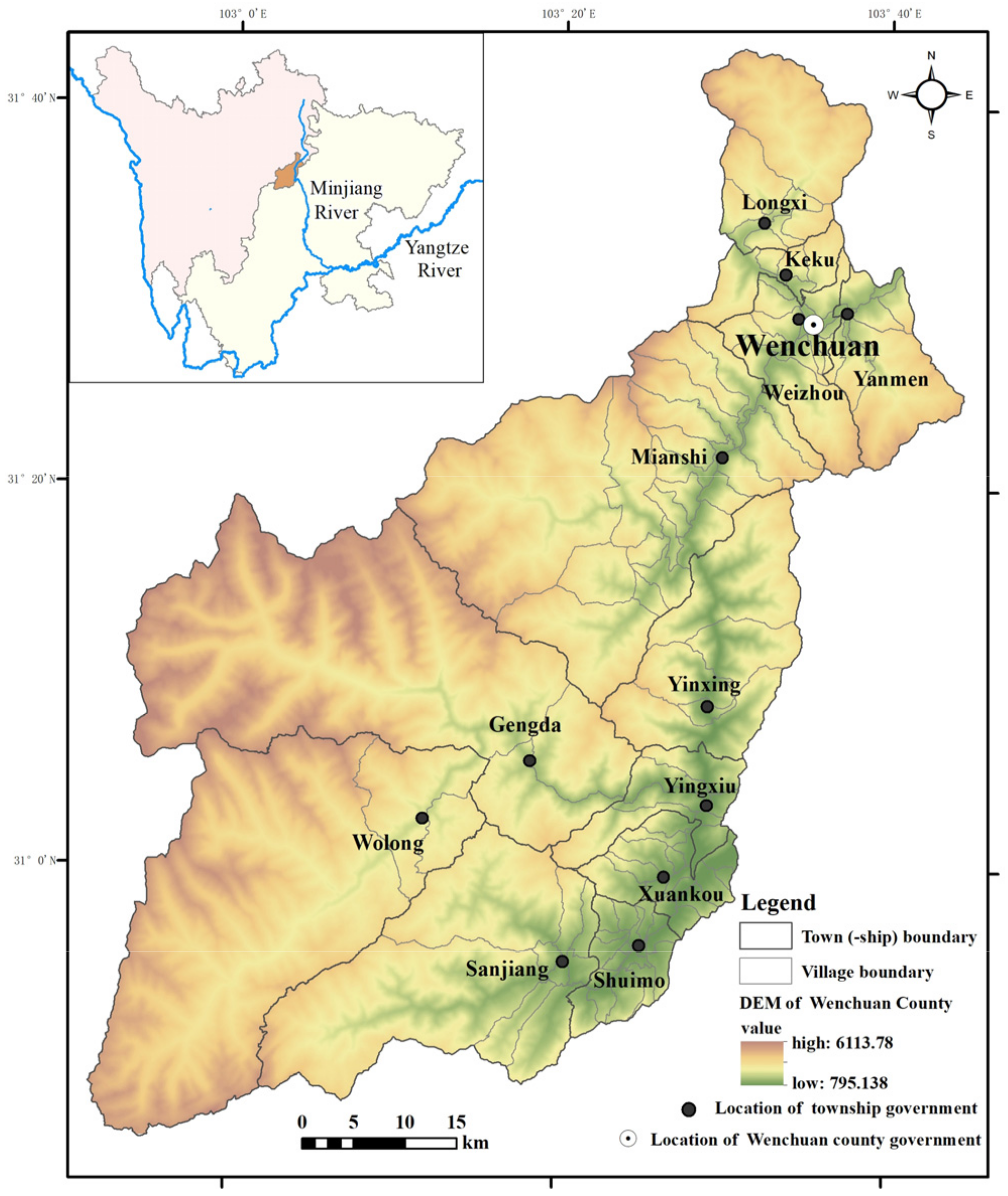
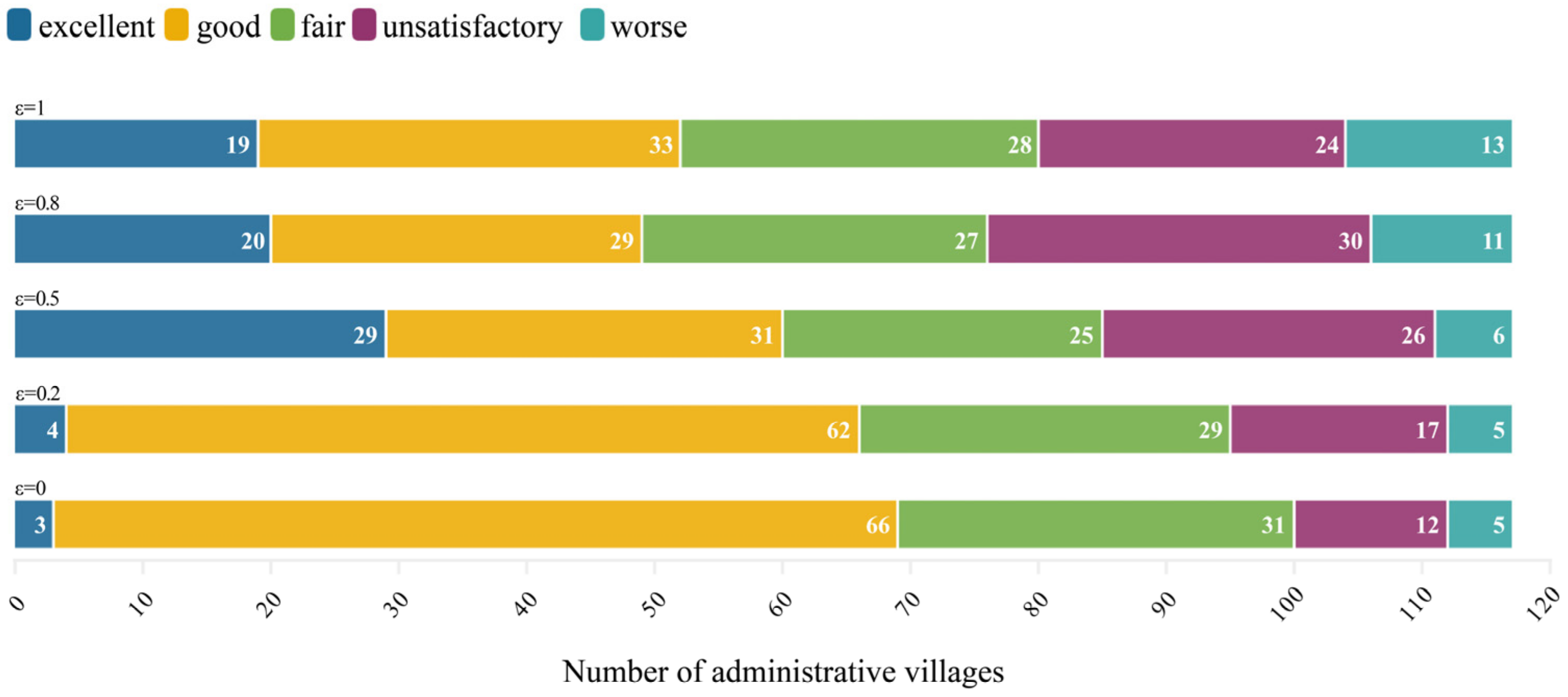
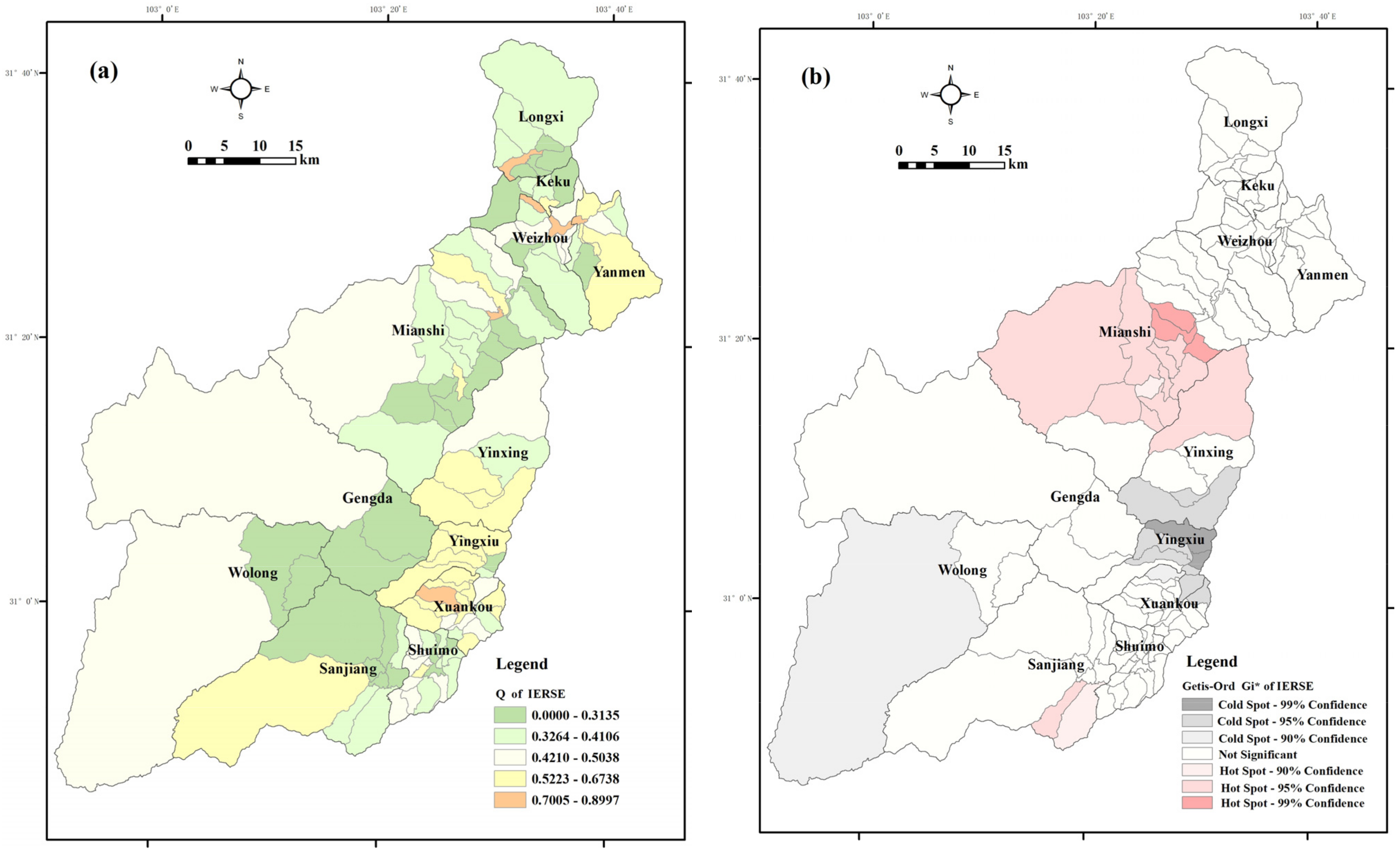
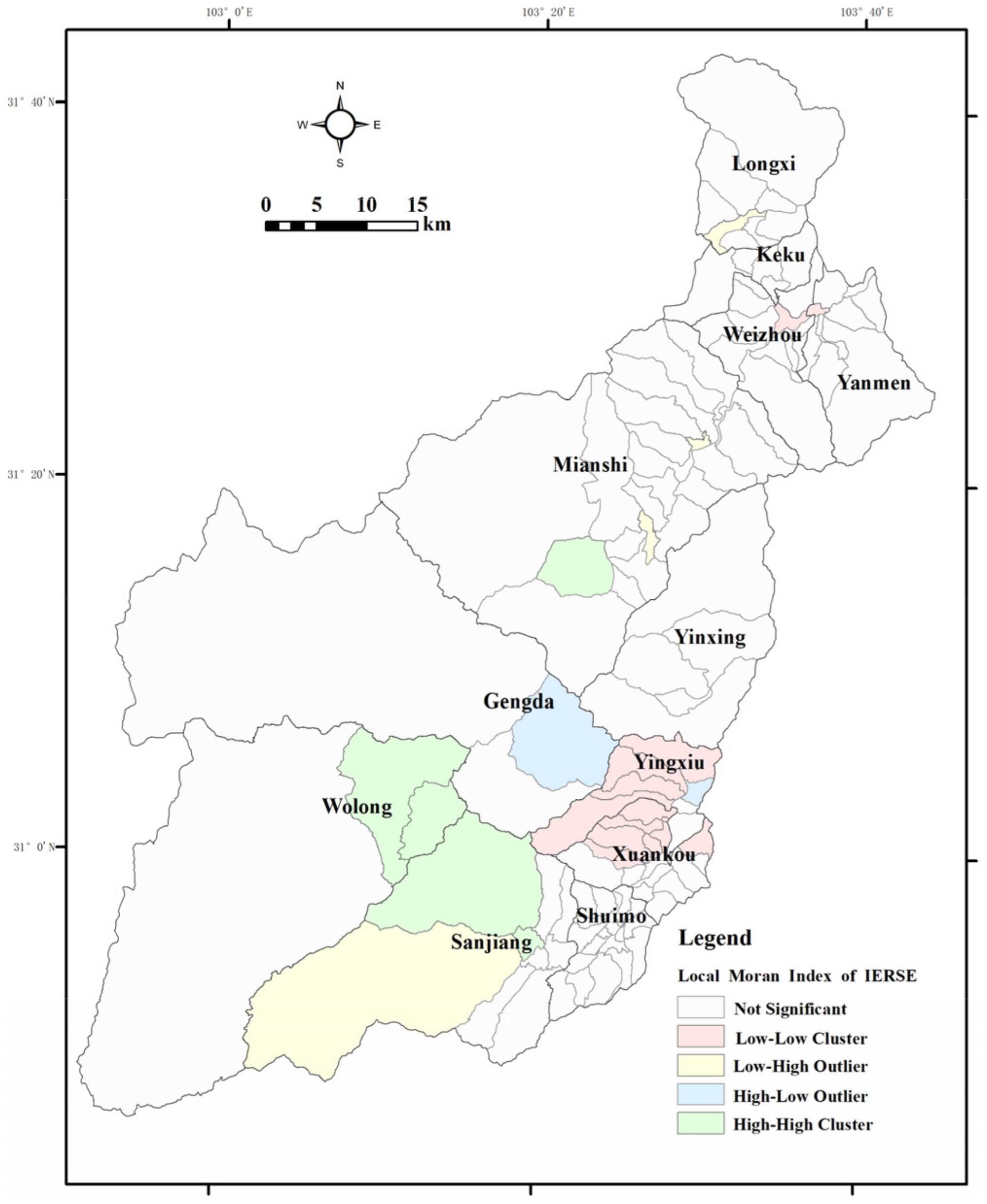
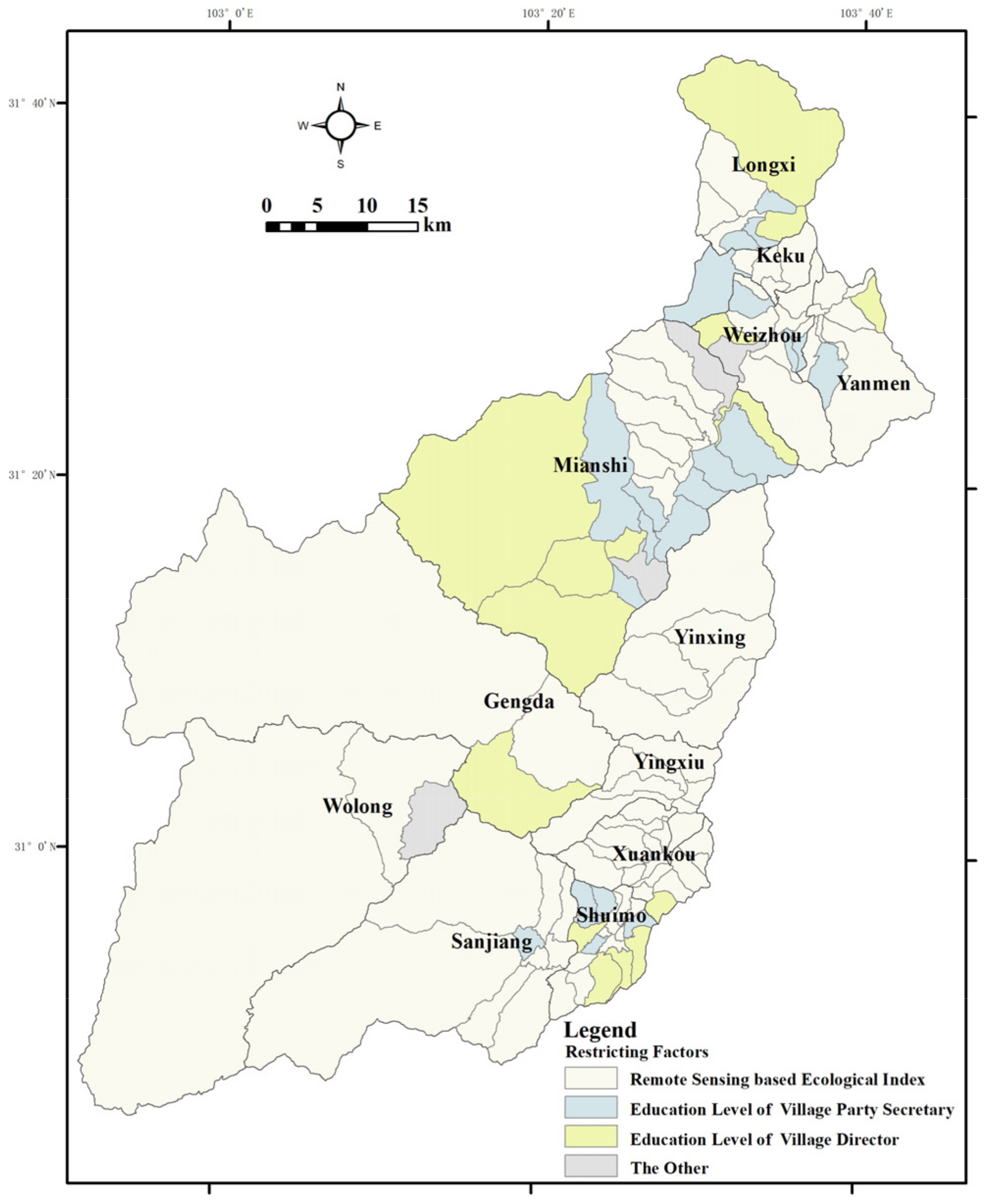

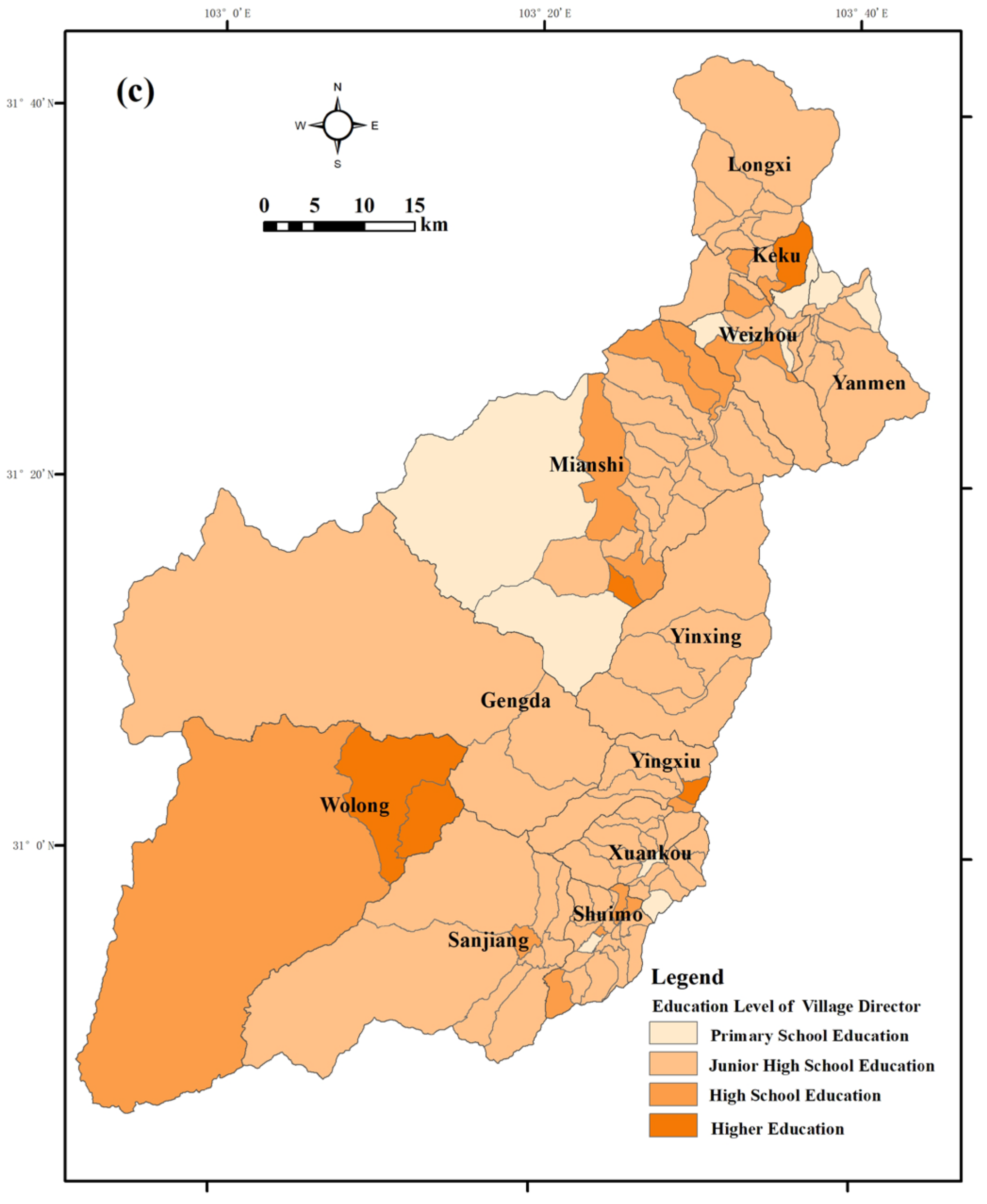
| Domains | Dimensions | Indicators | Attribution | Weight |
|---|---|---|---|---|
| ecological environment | ecological conservation | remote sensing based ecological index (RSEI) | benefit | 0.211 |
| human settlements | proportion of villager group with sanitary toilets | benefit | 0.037 | |
| proportion of households with centralized garbage collection | benefit | 0.052 | ||
| proportion of households with centralized sewage treatment | benefit | 0.063 | ||
| number of cleaners per hundred persons | benefit | 0.023 | ||
| agricultural environment | average chemical fertilizer application per 666 m2 | cost | 0.036 | |
| average pesticide application per 666 m2 | cost | 0.036 | ||
| recycling rate of agricultural waste utilization | benefit | 0.026 | ||
| social development | public services | proportion of village group with streetlights | benefit | 0.055 |
| proportion of village group with gas | benefit | 0.017 | ||
| proportion of farmers with tap water | benefit | 0.018 | ||
| number of clinics per hundred persons | benefit | 0.019 | ||
| number of sports squares | benefit | 0.055 | ||
| economic status | per capita disposable income of rural residents | benefit | 0.038 | |
| per capita village collective income | benefit | 0.031 | ||
| village tourism income | benefit | 0.054 | ||
| villagers’ autonomy | education level of village Party secretary | benefit | 0.094 | |
| education level of village head | benefit | 0.091 | ||
| number of villager meetings per year | benefit | 0.044 |
| Assessment Method | Advantages | Disadvantages |
|---|---|---|
| AHP | (1) Comprehensive coverage, scientific and reliable; (2) Evaluation structure is systematic and simple, easy to operate, low demand for quantitative data. | (1) Easily affected by subjective knowledge and experience; (2) Limited number of indicators, too many indicators leading to huge workload during calculation process. |
| DEA | (1) Dynamic traceability of computing process with weights as variables; (2) Suitable for evaluating multi-index input complex systems. | (1) Limited scope of application, mostly for sorting validity issues; (2) Just reflecting relative development of evaluation targets. |
| TOPSIS | (1) Calculation process simple and clear, the results presented objectively and quantitatively; (2) Suitable for handling multi-index dynamic evaluations. | (1) Relative importance of distances from the ideal and those from the negative ideal are not considered. |
| VIKOR | (1) Calculation process simple and clear, results objective and quantitative; (2) Suitable for multi-index dynamic assessment objects; (3) Comprising indicators’ negative impacts. | (1) To achieve full ranking, it needs to meet harsh constraints. |
| Evaluation Range | Administrative Village | Number of Villages in Different Town(ship)s | Classification |
|---|---|---|---|
| 0~0.3135 | Zhuanjinglou (WL), Longtan (MS), Jiecun (SJ), Heba (SJ), Gengda (GD), Mianfeng (MS), Xinqiao (WZ), EBu (LX), Yangdian (MS), Gaodian (MS), Madeng (LX), Dasi (KK), Zumushan (WL), Qishan (SJ), Fengxiangshu (YGX), Xiazhuang (KK), Longxi (LX), Lianghe (MS), Tongshan (YM), Xingfu (GD), Caoping (SJ), Zhaobi (SJ), Majiaying (SM), Zhangpai (MS), Xianfengyan (SM), Matou (MS), Bulan (LX), Banqiao (MS), Laoren (SM) | WL: 2; MS: 8; SJ: 5; GD: 2; WZ: 1; LX: 4; KK: 2; YGX: 1; YM: 1; SM: 3; XK: 0; YX: 0. | excellent |
| 0.3264~0.4106 | Qipangou (WZ), Keyue (MS), Huangjia (YGX), Banpo (MS), Zengpo (WZ), Longzhu (SJ), Dengjia (LX), Aer (LX), Wancun (WZ), Kuapo (LX), Maopingzi (SM), Liujiagou (SM), Zhouda (KK), Guojiaba (SM), Niutanggou (SM), Mushang (KK), Maliu (SJ), Diaotou (MS), Kechong (MS), Jinbo (MS), Gaofeng (SM), Shapingguan (YX), Qunyi (XK), Dacaotou (SM), Zhaojiaping (XK), Luobozhai (YM), Qiangfeng (MS), Damen (LX), Heping (MS), Baishui (YM), Xiaomaoping (MS) | WL: 0; MS: 8; SJ: 3; GD: 0; WZ: 3; LX: 3; KK: 2; YGX: 1; YM: 2; SM: 6; XK: 2; YX: 1. | good |
| 0.4210~0.5038 | Shapai (MS), Banzigou (MS), Bingli (WZ), Zhaiziping (SM), Dayandong (SM), Longtan (GD), Dengcaoping (SM), Cili (WZ), Baiguoping (SM), Anziping (XK), Niunaozhai (WZ), Jizhong (XK), Huangjiayuan (YGX), Baishi (SM), Taoguan (YX), Suoqiao (YM), Wolongguan (WL), Maoling (WZ), Baitukan (MS), Lianshanpo (SM), Yugongmiao (XK), Yubeiling (SM), Huangjiaping (SM), Chenjiashan (SM), Buwa (WZ) | WL: 1; MS: 3; SJ: 0; GD: 1; WZ: 6; LX: 0; KK: 0; YGX: 1; YM: 1; SM: 8; XK: 3; YX: 1. | fair |
| 0.5223~0.6738 | Hongfushan (XK), Kongshan (YM), Guxigou (XK), Laojie (YGX), Maidi (YM), Heitupo (SM), Keku (KK), Hetaoping (XK), Xingwenping (YX), Younian (XK), Dongjienao (YX), Yuzixi (YGX), Zuwan (MS), Wayaogang (XK), Xicao (SJ), Tuyushan (MS), Bajiaomiao (XK), Xianghuanggou (XK), Shuitianping (XK), Yiwanshui (YX), Yueli (YM), Shengyinsi (XK), Zhongtanbao (YGX), Zhangjiaping (YGX), Caijiagang (XK), Qingpo (YM) | WL: 0; MS: 2; SJ: 1; GD: 0; WZ: 0; LX: 0; KK: 1; YGX: 4; YM: 4; SM: 1; XK: 10; YX: 3. | unsatisfactory |
| 0.7005~0.8997 | Xiaomaxi (XK), Guojielou (YM), Shuanghe (WZ), Tieyi (WZ), Sanguanmiao (MS), Lianhe (LX) | WL: 0; MS: 1; SJ: 0; GD: 0; WZ: 2; LX: 1; KK: 0; YGX: 0; YM: 1; SM: 0; XK: 1; YX: 0. | worse |
Publisher’s Note: MDPI stays neutral with regard to jurisdictional claims in published maps and institutional affiliations. |
© 2022 by the authors. Licensee MDPI, Basel, Switzerland. This article is an open access article distributed under the terms and conditions of the Creative Commons Attribution (CC BY) license (https://creativecommons.org/licenses/by/4.0/).
Share and Cite
Zhang, J.; Zhang, S. Assessing Integrated Effectiveness of Rural Socio-Economic Development and Environmental Protection of Wenchuan County in Southwestern China: An Approach Using Game Theory and VIKOR. Land 2022, 11, 1912. https://doi.org/10.3390/land11111912
Zhang J, Zhang S. Assessing Integrated Effectiveness of Rural Socio-Economic Development and Environmental Protection of Wenchuan County in Southwestern China: An Approach Using Game Theory and VIKOR. Land. 2022; 11(11):1912. https://doi.org/10.3390/land11111912
Chicago/Turabian StyleZhang, Jifei, and Shuai Zhang. 2022. "Assessing Integrated Effectiveness of Rural Socio-Economic Development and Environmental Protection of Wenchuan County in Southwestern China: An Approach Using Game Theory and VIKOR" Land 11, no. 11: 1912. https://doi.org/10.3390/land11111912
APA StyleZhang, J., & Zhang, S. (2022). Assessing Integrated Effectiveness of Rural Socio-Economic Development and Environmental Protection of Wenchuan County in Southwestern China: An Approach Using Game Theory and VIKOR. Land, 11(11), 1912. https://doi.org/10.3390/land11111912







